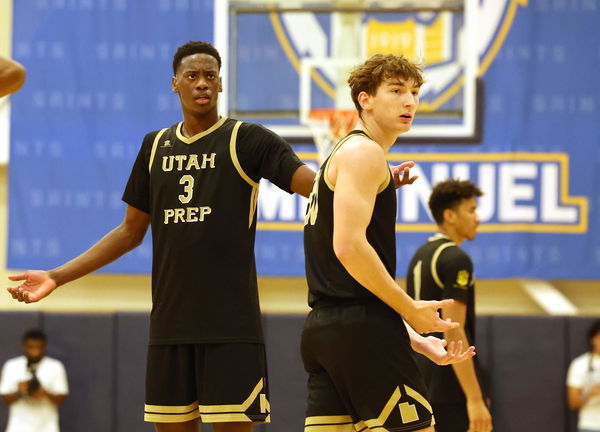
via Imago
Utah Prep’s AJ Dybantsa, left, during a game against Highland School at Emmanuel College in Boston on Tuesday, Nov. 5, 2024.

via Imago
Utah Prep’s AJ Dybantsa, left, during a game against Highland School at Emmanuel College in Boston on Tuesday, Nov. 5, 2024.
The Name, Image, and Likeness (NIL) era was going to be a game-changer for college players, offering financial freedom when playing in college. Further, Title IX was established to deliver equality in college sports, and root out any discrimination. What happens when the same programs that rely on these protections start to disappear, though?
Over the span of three months, a different NCAA non-revenue Olympic sport has been cut every three days. Institutions earn significant amounts of money in media rights, sponsorships, and donations, yet smaller sports continue to be eliminated at a jaw-dropping rate. The question is staring everyone in the face in bold relief: what is the point of Title IX when there is nothing to be protected anymore?
When the NCAA lifted restrictions on Name, Image, and Likeness (NIL) deals, it changed college sports overnight. Top football and basketball players signed multimillion-dollar endorsements, social media endorsements, and business arrangements overnight, with many incoming freshmen making more money than some of the professional players without even having laced up their shoes. While NIL changed college sports overnight for a privileged few, the ripple impact was a debacle for many more.
ADVERTISEMENT
Article continues below this ad
"There's so much money in college athletics!!"
Fact: For the past 3 months, on average, 1 NCAA non-revenue Olympic sports program has been completely eliminated every 3 days.
— NIL vs NLI (@NILvsNLI) February 13, 2025
The rise in NIL money has not resulted in a more even distribution of resources in college sports. The opposite is happening, with revenue sports such as football and men’s basketball getting more money, while revenue sports such as wrestling, gymnastics, swimming, and track and field are suffering the consequences of budget-cutting decisions. More than a dozen such programs have been eliminated in the last three months, their budgets deemed too expensive by their respective institutions despite their record media deals. Cleveland State University, which previously rescued its wrestling team using a student-approved athletic fee, has cut it completely. And it is not alone in making such decisions.
The irony is difficult to ignore. College athletics is generating more money than ever before, and yet smaller programs are disappearing at a record rate. The same system that’s allowing multimillion-dollar contracts to be a reality for its star players is also destroying entire programs that can’t keep up in this new era of money.
The Title IX debate: Equal rights are worthless without programs
For decades, Title IX has been a promise of gender equality in college sports, ensuring equal funding, scholarships, and protection of women’s sports participants. With the evolving financial picture of college sports, though, Title IX’s impact is diminishing. Recent court rulings and policy amendments have rewritten the rules, striking down key protections that previously ensured equality.
ADVERTISEMENT
Article continues below this ad
What’s your perspective on:
Is NIL the death knell for non-revenue sports, or can they survive this financial storm?
Have an interesting take?
During the Biden administration, there was a move to broaden Title IX to encompass NIL payments, requiring that schools distribute NIL money equally to male and female players. That policy didn’t survive. The Trump administration canceled the Title IX NIL guidance, indicating that NIL earnings wouldn’t be included in Title IX. Trump’s guidance was also upheld in a federal court decision that said that NIL payments aren’t “athletic financial assistance” and that schools need not provide female players with their fair share of financial support.
This shift has created a dramatic skew in college sports. With Title IX no longer applicable to NIL, colleges can discriminate in favor of their money sports—football and men’s basketball—with impunity. The women’s sports and men’s sports that do not produce revenue hang in the balance of budget cutbacks and program eliminations.
The implications of such a step already loom large. Former college players and lawyers warned that such a move would reverse decades of progress toward gender equality in college athletics. Former Office of Civil Rights Assistant Secretary Catherine Lhamon was one of those expressing discontent, calling the move “appalling” and noting that financial equality is paramount to providing equality in sports. With men’s players in high-revenue sports dominating the NIL marketplace, removing Title IX regulation puts women’s players at a serious disadvantage financially as well as in maintaining programs.
ADVERTISEMENT
Article continues below this ad
What happens next? College athletics is standing at a crossroads. As basketball players and football players continue to earn profits in NIL deals, Olympic sports are getting cut at a never-before-seen scale. The protections that Title IX once provided are increasingly colliding with limits that would expose entire programs to budget cuts. The question is no longer one of equality in the distribution of NIL—it is one of whether generations of players to come will even be competing in programs that continue to be in existence.
If the trend is permitted to continue, NIL won’t open up new college sports possibilities but redefine them, with a mere handful of sports continuing to exist and the rest eliminated altogether. Title IX was created to give a level playing ground, yet without programs to support it, its effects are diminishing at a quickened pace. The controversy over equality in college sports is just beginning, and when more programs get eliminated, the brutal reality of what NIL is going to do to college sports is just starting to be felt.
ADVERTISEMENT
ADVERTISEMENT
ADVERTISEMENT
ADVERTISEMENT


Is NIL the death knell for non-revenue sports, or can they survive this financial storm?